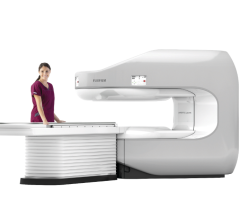
Image courtesy of Esaote
November 9, 2018 — Medical imaging company Esaote and The BioRobotics Institute of Scuola Superiore Sant’Anna in Pisa, Italy, have developed a new robotic cell to help optimize the testing of ultrasound probes. The robotic cell, under the guidance of an operator, is able to direct the transducer and certify its effectiveness.
The outcomes of this collaboration were summarized in the report “Pulse-echo test for medical imaging ultrasound probe and collaborative robot: performance and usability”, written by Marco Controzzi, Michele Bacchereti and Francesco Clemente of The BioRobotics Institute, and Andrea Grandoni, Lorenzo Francalanci and Alessandro Fabbrizzi of Esaote.
The robotic cell allows cooperation between human labor and advanced automation systems. This offers an integrated solution, and it makes the tests more efficient and traceable. The robotic cell consists of a collaborative robotic arm with a gripper that can verify the correct position of the probes with the help of on operator. Esaote said this is an important step towards the automation of the process that allows users to have more precise data about the repeatability and the operation of the probe. Currently, all of the tests take place manually, with the only intervention of the operator.
“The robotic cell has reached two goals,” said Marco Controzzi, researcher at The BioRobotics Institute. “The first is to automate the procedure for the operation of the tests; the second is to keep in the foreground the role of man. Esaote operators will interact with the robot, supporting it during the tests. This line of research reflects the mission of “Human-Robot-Interaction”, the laboratory of Collaborative Robotics of The BioRobotics Institute. We imagine a synergy between men and robots, combining the advantages of manual production with precision and repeatability of automation.”
For more information: www.esaote.com


 July 30, 2024
July 30, 2024 








